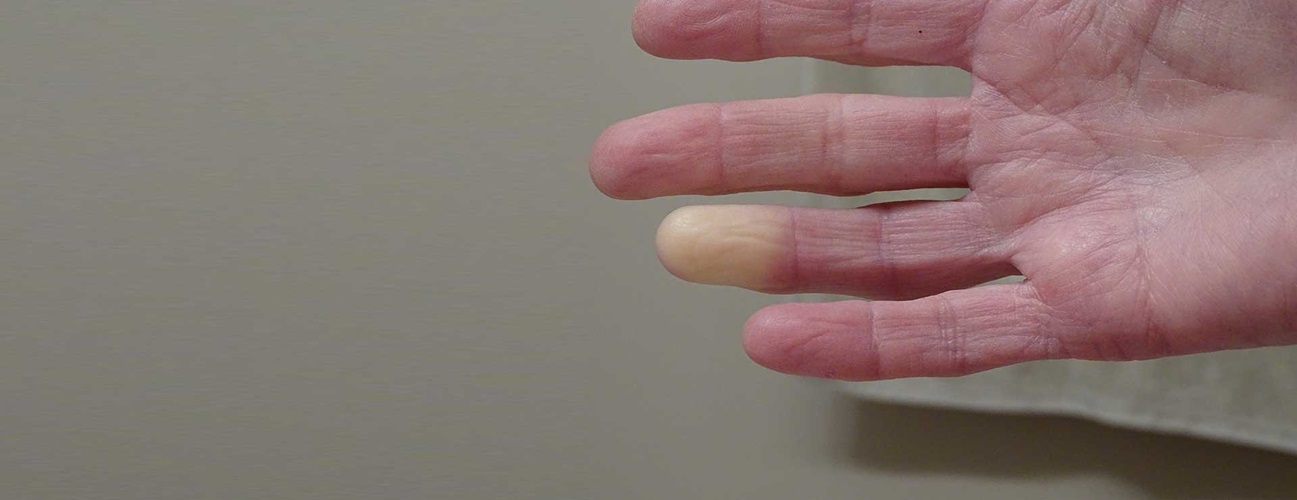Raynaud's Phenomenon
What is Raynaud's phenomenon?
Raynaud's phenomenon is a problem that causes decreased blood flow to the fingers. In some cases, it also causes less blood flow to the ears, toes, nipples, knees, or nose. This happens because of spasms of blood vessels in those areas. The spasms happen in response to cold, stress, or emotional upset.
Raynaud's can occur on its own. This type is known as its primary form. Or the condition may happen along with other diseases. This type is known as its secondary form. The diseases most often linked with Raynaud's are autoimmune or connective tissue diseases, such as:
-
CREST syndrome (a form of scleroderma)
-
Buerger disease
-
Occlusive vascular disease, such as atherosclerosis
-
Polymyositis
-
Blood disorders
-
Thyroid disorders
-
Pulmonary hypertension
The primary form of Raynaud's is the most common type. It often starts between ages 15 and 25. It’s less severe than secondary Raynaud's. People with primary Raynaud's don't often develop a related condition. It is most common in people assigned female at birth and people living in cold climates. Secondary Raynaud's often develops later in midlife, between ages 35 and 40.
What causes Raynaud's phenomenon?
Healthcare providers don't know the exact cause of Raynaud's. It's possible that some blood disorders may cause Raynaud's by increasing the blood thickness. This may happen from extra platelets or red blood cells. Or special receptors in the blood that control the narrowing of the blood vessels may be more sensitive.
Who is at risk for Raynaud's phenomenon?
Certain factors can increase your risk for Raynaud's. They include:
-
A connective tissue or autoimmune disease
-
Chemical exposure
-
Cigarette smoking
-
Injury or trauma
-
Repetitive actions, such as typing or using tools that vibrate, such as a jackhammer
-
Side effects from certain medicines
-
Carpal tunnel syndrome
-
Being assigned female at birth
-
Living in a cold climate
What are the symptoms of Raynaud's phenomenon?
Symptoms can occur a bit differently in each person. Common symptoms include:
-
Fingers that turn pale or white then blue when exposed to cold, or during stress or emotional upset. They turn red when the hands are warmed and blood flow returns.
-
Hands that may become swollen and painful when warmed
-
In severe cases, sores on the finger pads
-
In rare cases, gangrene in the fingers that causes infection or needs amputation
How is Raynaud's phenomenon diagnosed?
Your healthcare provider will ask about your health history and do a physical exam. Your provider may also do a cold challenge test. It is done to see the color changes in the hands and fingers. During the test, your hands are exposed to cold. Your healthcare provider may also look at the tiny blood vessels in your fingernails with a microscope. Adults who start to have Raynaud's phenomenon after age 35 may be tested for an underlying disease. You may have blood tests to see if your condition is primary or secondary.
How is Raynaud's phenomenon treated?
Treatment will depend on your symptoms, your age, and your general health. It will also depend on how severe the condition is. There is no known cure for Raynaud's phenomenon. But symptoms can be managed with correct treatment. Treatment and preventive measures may include:
-
Limiting exposure to cold
-
Keeping warm with gloves, socks, scarf, and a hat
-
Stopping smoking
-
Wearing finger guards over fingers with sores
-
Preventing trauma or vibrations to the hand, such as with vibrating tools
-
Taking blood pressure medicines during the winter months to help reduce blood vessel constriction
Talk with your healthcare providers about the risks, benefits, and possible side effects of all medicines.
What are possible complications of Raynaud's phenomenon?
In severe cases, you may have sores on finger pads. These sores may progress to gangrene. In rare cases, gangrene may lead to finger amputation.
Living with Raynaud's phenomenon
For most people living with Raynaud's, it is more of an inconvenience than a serious problem. Attacks may last from a few minutes to more than an hour. Staying away from triggers, mainly cold, can reduce the spasms that lead to symptoms. If there is an underlying cause, such as scleroderma or lupus, it may be harder to manage attacks. If you have secondary Raynaud's, work with your healthcare provider to manage your underlying condition. This may help decrease attacks of Raynaud's.
When should I call my healthcare provider?
If your symptoms get worse or you have new symptoms, let your healthcare provider know.
Key points about Raynaud's phenomenon
-
Raynaud's phenomenon is a disorder that causes decreased blood flow to the fingers. In some cases, it also causes less blood flow to the ears, toes, nipples, knees, or nose.
-
Spasms of blood vessels happen in response to cold, stress, or emotional upset.
-
Secondary causes of Raynaud's include other conditions, such as lupus and scleroderma.
-
Symptoms of Raynaud's include fingers that turn pale or white then blue when exposed to cold, or during stress or emotional upset. They then turn red when the hands are warmed and blood flow returns.
-
Managing Raynaud's means not being cold, dressing warmly, and stopping smoking.





